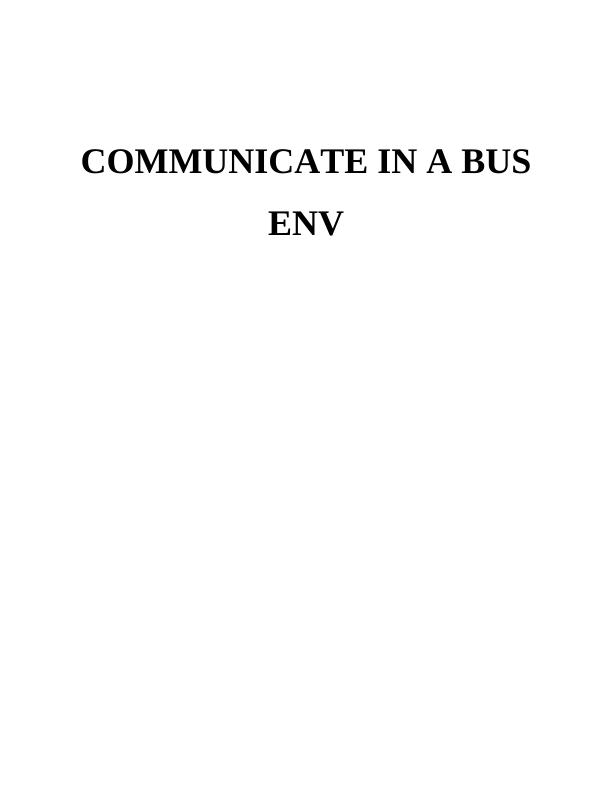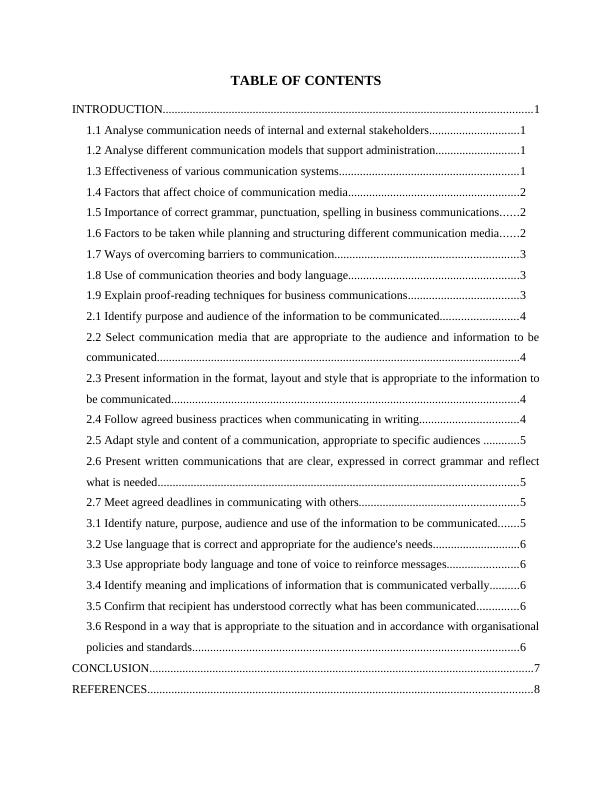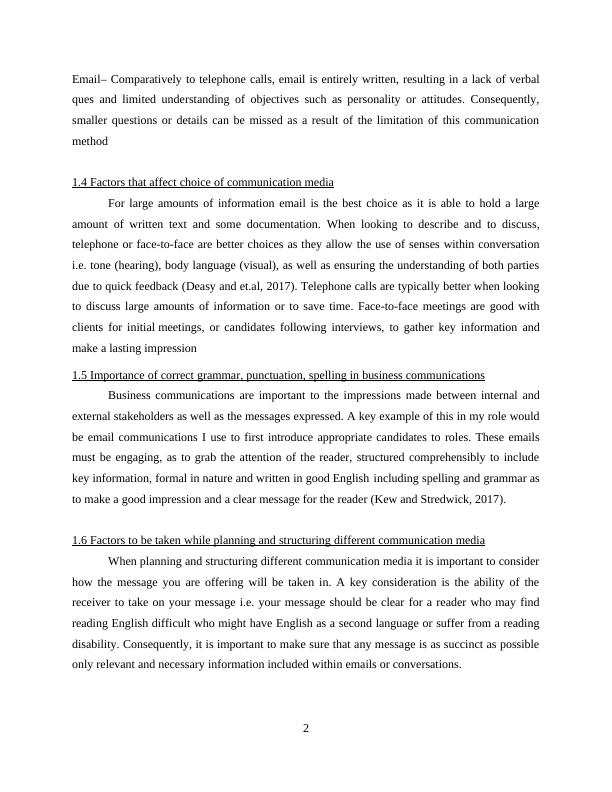Communication in Bus Econv TABLE OF CONTENTS INTROUCTION
11 Pages2953 Words63 Views
Added on 2020-06-06
About This Document
COMMUNICATE IN A BUS ENV TABLE OF CONTENTS INTRODUCTION 1 1.1 Analyse communication needs of internal and external stakeholders 1 1.2 Analyse different communication models that support administration 1 1.3 Effectiveness of various communication systems 1 1.4 Factors that affect choice of communication media 2 1.5 Importance of correct grammar, punctuation, spelling in business communications2 1.6 Factors to be taken while planningand understandingdifferent communication media 2 1.7 Ways of overcoming communication barriers to communication3 1.8 Use of communication theories and body language3 1.9
Communication in Bus Econv TABLE OF CONTENTS INTROUCTION
Added on 2020-06-06
ShareRelated Documents
COMMUNICATE IN A BUSENV

TABLE OF CONTENTSINTRODUCTION...........................................................................................................................11.1 Analyse communication needs of internal and external stakeholders..............................11.2 Analyse different communication models that support administration............................11.3 Effectiveness of various communication systems............................................................11.4 Factors that affect choice of communication media.........................................................21.5 Importance of correct grammar, punctuation, spelling in business communications......21.6 Factors to be taken while planning and structuring different communication media......21.7 Ways of overcoming barriers to communication.............................................................31.8 Use of communication theories and body language.........................................................31.9 Explain proof-reading techniques for business communications.....................................32.1 Identify purpose and audience of the information to be communicated..........................42.2 Select communication media that are appropriate to the audience and information to becommunicated.........................................................................................................................42.3 Present information in the format, layout and style that is appropriate to the information tobe communicated....................................................................................................................42.4 Follow agreed business practices when communicating in writing.................................42.5 Adapt style and content of a communication, appropriate to specific audiences ............52.6 Present written communications that are clear, expressed in correct grammar and reflectwhat is needed........................................................................................................................52.7 Meet agreed deadlines in communicating with others.....................................................53.1 Identify nature, purpose, audience and use of the information to be communicated.......53.2 Use language that is correct and appropriate for the audience's needs.............................63.3 Use appropriate body language and tone of voice to reinforce messages........................63.4 Identify meaning and implications of information that is communicated verbally..........63.5 Confirm that recipient has understood correctly what has been communicated..............63.6 Respond in a way that is appropriate to the situation and in accordance with organisationalpolicies and standards.............................................................................................................6CONCLUSION................................................................................................................................7REFERENCES................................................................................................................................8

INTRODUCTIONThe present report highlights importance of business communication to improve work inthe company and avoid duplication of work.1.1 Analyse communication needs of internal and external stakeholdersInternal: Communication internally can be less formal due to familiarity betweenmembers of a team if between colleagues. However, it is typically informative in nature, i.e.regarding sales processes, business requirements/needs, or performance.External: This type of communication is varies largely on what the business wants/needs from itsexternal audience. In terms of investors, a company would be more honest with figures than itwould with customers/consumers, i.e. margin profits or company performance, in order to securemoney from individuals. Similarly, with regulators companies will be honest in terms of relevantdocuments/information due to avoid legal issues. Comparatively, customers and suppliers willhave limited information (Charter, 2017). 1.2 Analyse different communication models that support administrationCommunication is a key element to business success both internally and externally. 1. Shannon and Weaver Model Of Communication (1948) – This is one of the earliest models ofcommunication and lays out the process of conversation to evidence what could go wrong from‘source’ to ‘receiver’ as a message encoded’ and ‘decoded’ by two people.2. Schramm’s Model (1954) alters this simplistic model, showing thatencoding and decoding isnot a one-sided process and that by converting ideas into words humans are constantly encodingand decoding messages to be decoded and encoded again.3. Berlo’s Model (1960) further alters Shannon and Weaver’s model - Stressing the relationshipbetween the sender and receiver of messages byhighlighting the communication skillsandperceptions which allow people to encode and decode messages as they do.1.3 Effectiveness of various communication systemsTelephone calls are an effective communication method in business due to the ability tostructure messages simplistically and employ tone to ensure understanding between both partiesand to better understand intention.1

Email– Comparatively to telephone calls, email is entirely written, resulting in a lack of verbalques and limited understanding of objectives such as personality or attitudes. Consequently,smaller questions or details can be missed as a result of the limitation of this communicationmethod1.4 Factors that affect choice of communication mediaFor large amounts of information email is the best choice as it is able to hold a largeamount of written text and some documentation. When looking to describe and to discuss,telephone or face-to-face are better choices as they allow the use of senses within conversationi.e. tone (hearing), body language (visual), as well as ensuring the understanding of both partiesdue to quick feedback (Deasy and et.al, 2017). Telephone calls are typically better when lookingto discuss large amounts of information or to save time. Face-to-face meetings are good withclients for initialmeetings, or candidates following interviews, to gather key information andmake a lastingimpression1.5 Importance of correct grammar, punctuation, spelling in business communicationsBusiness communications are important to the impressions made between internal andexternal stakeholders as well as the messages expressed. A key example of this in my role wouldbe email communications I use to first introduce appropriate candidates to roles. These emailsmust be engaging, as to grab the attention of the reader, structured comprehensibly to includekey information, formal in nature and written in good Englishincluding spelling and grammar asto make a good impression and a clear message for the reader (Kew and Stredwick, 2017).1.6 Factors to be taken while planning and structuring different communication mediaWhen planning and structuring different communication media it is important to considerhow the message you are offering will be taken in. A key consideration is the ability of thereceiver to take on your message i.e. your message should be clear for a reader who may findreading English difficult who might have English as a second language or suffer from a readingdisability. Consequently, it is important to make sure that any message is as succinct as possibleonly relevant and necessary information included within emails or conversations.2

End of preview
Want to access all the pages? Upload your documents or become a member.
Related Documents
Report on Business Communication Process Systemlg...
|13
|3007
|61
Communicate in a Business Environmentlg...
|11
|2937
|404
Communicate in a Business Environment Essaylg...
|10
|2831
|113
Business Communication Systems: Factors affecting business communicationlg...
|10
|2846
|367
Communicate in Business Environmentlg...
|12
|3640
|72
Communicate in a Business Environment : Assignmentlg...
|11
|3270
|85
